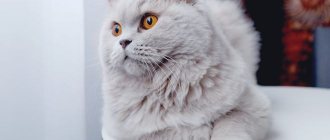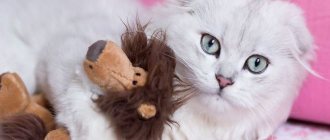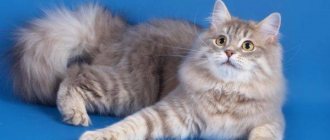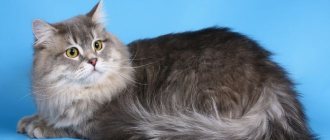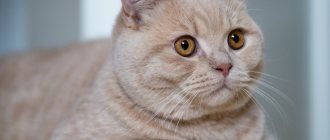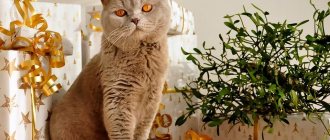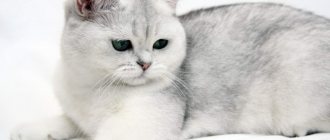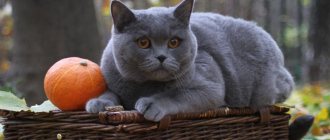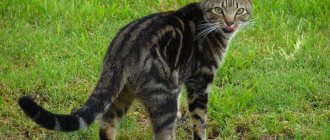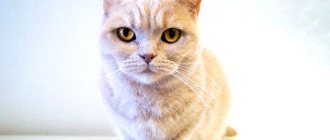The Highlander is an American experimental cat breed that was developed by crossing the Desert Lynx and the Jungle Curl. Distinctive features of the Highlander: a short tail, curled ears and a tabby pattern. By nature, this is an ordinary domestic cat, somewhat independent, affectionate and playful. Other names for the breed: Highlander shorthair or Highland Lynx.
Brief history of the breed
Work on breeding Highlanders began in 1993, when breeders decided to improve the already existing Desert Lynx cat variety. To make their ears curled, experts used representatives of the new hybrid breed Jungle Curl (obtained by crossing Bengals, Serengeti, Egyptian Mau, American Curls, Chausie, etc.).
As a result, the breeders managed to fix the folded ears while maintaining the spotted lynx coloring. In May 2008, the Highlander cat breed received recognition from TICA, and from 2021 it can be exhibited in the Advanced new breed class.
Read more - “About different breeds of cats with curled ears.”
Interesting Facts
Although the Highlanders do not have a rich history, many interesting things have been associated with them:
- The name of the breed Highland Lynx translates as “mountain lynx”. And in some sources these cats are referred to as shorthaired Highlanders.
- Due to the similar name, representatives of the breed are often confused with Highland Folds. But they are in no way related to the British and Scottish Longhairs.
- Formally, Highland Links can be considered hybrids. But the percentage of wild blood present in them is so small that it does not affect anything at all. Therefore, genetically, Highlanders are completely domestic cats that do not pose a threat to people.
Origin story
In the 20th century, a group of felinologists decided to crossbreed the British Shorthair breed with Persians. Since both species are considered purebred, there was a desire to get even more beautiful cats. The British had short-haired cats and some had long-haired ones, but felinologists wanted to get cats with thicker hair and new colors. The first attempts turned out to be failures: the kittens had disturbed skull proportions and an uneven jaw. After which it was forbidden to cross these breeds. Fortunately, some kittens were born healthy and beautiful. Thanks to them, British longhair cats continue to exist.
It was only at the beginning of the 21st century that the British Longhair cat began to be considered as a separate breed. She has been officially recognized by TICA and the world organization WCF since 2009. In other systems, British longhairs have not received full status and are considered an experiment.
Breed description, standards, appearance
Highlanders are muscular, compact cats with short tails and ears turned outward. Outwardly, they resemble strong and agile lynxes.
Dimensions and weight
Highlanders are fairly large cats with pronounced sexual dimorphism. The average weight of a female is 4.5-6.5 kg. The weight of a male Highland Lynx varies between 6.5-9 kg.
Anatomical characteristics
A typical Highlander cat should fit the following description:
- The head is triangular, with rounded cheekbones, a convex skull, a high forehead, a short blunt muzzle, pronounced whisker pads and a wide nose.
- The eyes are almond-shaped, medium-sized, slanting, widely set. The iris of the Highland Lynx can be green, orange or yellow.
- The ears are medium in size, with a wide base and flexible, curved back tips.
- The body is rectangular in shape, with a straight back, slightly raised croup and well-developed muscles.
- The limbs are of medium length, with rounded paws and pronounced knuckles.
- The tail is thick and short. Its length in Highland Links should not be less than 2.5 cm and longer than the hock joints.
On a note. The Highlander is one of the few breeds in which polydactyly is acceptable.
Color and coat type
The body of the Highland Lynx is covered with beautiful fur, the texture of which depends on the length and color. A cat of this breed is:
- shorthair - with a thick coat and dense undercoat;
- long-haired - with developed decorative hair, which, as it were, forms trousers and a frill.
According to the Highland Lynx breed standard, spotted, marbled or striped tabbies in any color combination are allowed.
On a note. The color of the Highlander's coat is determined by the tone of the undercoat. For example, if a cat's fur appears to be silver-black and her underpads are brown, then her color would be considered brown.
Possible breed defects
Exterior defects, the presence of which reduces the breeding value of the Highland Links:
- weak bones;
- the tail is shorter than 2.5 cm and longer than the hocks;
- ears are bent more than 90 degrees.
Breed cost
The British Longhair cat is a popular breed, so finding a cattery or breeder is not difficult. Individuals on sales sites should be treated more closely. It is difficult to judge the purebred cat breed from a photograph; it is better to see the kitten and its parents in person. Another equally important question is the cost of the kitten. The price depends on the following factors:
- Floor. Cats are a little more expensive than female cats.
- Class (pet, brit, show, ascending price respectively).
- Parents' pedigree.
- Color.
- Prestige of the nursery, breeder from whom you plan to purchase.
The most expensive show-class kitten, intended for exhibitions and breeding, costs approximately $1,500-2,000. For a small price you can get a “defective” fluffy Briton who was born from short-haired parents with a recessive gene for long hair.
Choosing a kitten
It is recommended to purchase kittens at the age of 3-4 months. They are already accustomed to the tray, scratching post and vaccinated with the vaccine appropriate for their age.
Before buying a pet, you should decide for what purpose you are purchasing a British dog. For participation in exhibitions and breeding of the breed, the show class or breeding class with minor flaws in appearance is ideal. The Pet class is suitable as a stay-at-home pet, because... it is not allowed in exhibition events due to serious deviations from breed standards and is subject to mandatory castration, preventing breeding activities.
A kitten without papers is temptingly inexpensive, but there are no guarantees about its purebred. Only a specialist can name the class, but you can determine the purebredness of a kitten yourself by the characteristics characteristic of British cats:
- Round head with a wide forehead.
- Chubby cheeks.
- Small rounded ears.
- Medium-sized nose with no visible transition in the eye area.
- Fluffy elongated coat.
You can verify the purebred in another way - please provide the relevant documents: birth certificate, pedigree, veterinary passport and others. The third option is to look at both or one of the baby’s parents. The health of the cat is an important criterion for choosing a pet:
- Active, curious.
- Neat appearance with shiny coat.
- Clear, clean eyes without discharge.
- Skin without damage.
- Clean ears without plaque.
Character and temperament
The Highlander is a cat with a friendly and gentle disposition. He likes to be the center of everyone's attention, and he achieves this through funny pranks.
The curious Highland Lynx explores new places with the enthusiasm of a true explorer, but does not go on a “race” through curtains and closets.
On a note. Highlanders are not particularly talkative. To express emotions, representatives of the breed prefer to use tail wagging or an ingratiating look into the eyes of their owners.
The friendly nature of Highlanders allows them to easily find a common language with children. Non-jealous and calm cats never respond with aggression to childish pranks. Highland Links also easily get along with other pets and get along peacefully with all animals, including rodents, reptiles and birds.
Personality of the British Longhair cat
The longhaired British cat is the embodiment of delicacy and peacefulness itself. Actually, for these character traits alone, representatives of the breed can be recommended to owners who want to have a problem-free pet next to them, to whose whims they do not have to adapt. Lowlanders are extremely moderate in their preferences and do not cross the line beyond which misunderstandings and friction with the owner begin. For example, furry intellectuals adore human company, but in his absence they do not fall into depression, preferring to quietly philosophize on their favorite couch or armchair. By the way, breeders who have many years of experience in breeding the breed claim that the character of their charges is more docile and good-natured than that of short-haired British cats.
Kittens also experience attacks of mild melancholy, during which they are reluctant to contact the owner and members of his family. During such periods, it is better not to pester your pet, giving him the opportunity to take a slight break from communication - don’t worry, this withdrawal will not last long. Morning oratorios while waiting for breakfast are also not about the British. From time to time, English “gentlemen” are able to remind themselves with a quiet, slightly rolling “meow”, but they certainly will not scream to attract attention or in confusion of feelings.
But the long-haired Briton will not refuse to play, and this comrade perceives with equal delight both entertainment in the company of a person and the independent “torment” of a wind-up mouse or ball. As they grow up, British Longhairs become more phlegmatic and slow down in terms of physical activity, so anyone who is scared of hurricane cats, dashingly diving from the closet to the sofa and overturning flower pots of any weight, can get such a pet.
Purrs treat children patiently and condescendingly, provided that the latter do not annoy the animal too much with their attention. When bringing a British Longhair cat into your home, inform your children that the breed does not like strong hugs, nor does it like a noisy, nervous environment. We are ready to tolerate lowlanders and the presence of dogs. True, in order for the relationship between the dog and the representative of the purring brethren to become extremely peaceful, it is better that acquaintance and getting used to each other take place at a young age.
How to choose the right kitten
The Highlander is an expensive and rare breed of cat. Leading breeders specializing in breeding such animals live in the United States. Therefore, you will most likely have to choose a Highland Lynx kitten in absentia. In this case, it is advisable to focus on the following criteria:
- availability of pedigree and veterinary passport;
- conditions of detention;
- behavioral characteristics;
- compliance with the breed standard;
- health status.
On a note. Highlander kittens are born straight-eared. As they grow, the tips of their ears curl back.
Choosing a kitten and its price
The longhaired British breed has many fans, so getting a kitten will not be a problem. Please note that the price of a cat is always cheaper than a cat. Also, the cost will depend on the color, purity of the pedigree (presence of Persians), and the status of the nursery. Kittens with appropriate documentation are more expensive.
There is a division into classes: show, breed and pet. Exhibition representatives are more expensive than usual, their price starts from 15,000 rubles. An ordinary kitten for home can be found through private advertisements from 3,000 rubles. Be careful when choosing and beware of scammers. Look at the parents and the rest of the kittens. Make sure you are paying for a British Longhair and not just a fluffy kitten.
Care and maintenance
Unpretentious Highland Links are able to quickly adapt to any conditions. They live in apartments and private houses without any problems. Caring for Highlanders includes a number of standard procedures:
- The eyes and ears of cats are regularly examined for the presence of nonspecific discharge and wiped with cotton pads soaked in alcohol-free products.
- Highlanders' claws grow very quickly and break off. Therefore, they are systematically shortened with a nail cutter so as not to affect the blood vessels. And to prevent cats from tearing wallpaper and upholstered furniture, they are provided with scratching posts.
- Highlanders' teeth are brushed several times a week with a non-foaming paste using a special silicone brush or soft brush.
- Cats of this breed are bathed 3-4 times a year or as needed. Bath procedures are carried out in warm rooms where there are no drafts. And for washing they use special shampoos.
- Long-haired Highland Links require careful grooming. They are systematically combed out with a slicker brush or a brush with soft bristles. The hair of shorthaired Highlanders is treated several times a week with a special glove.
Character
The character of small British longhair kittens is active and playful. They show interest in everything around them. It is easy to explain to them what is and is not possible. Therefore, you can quickly accustom them to the tray. Animals have an attachment to their family. They are patient with children and their pranks. They get along easily with other animals in the house.
The adult life of the British is very calm, it is difficult to anger them. They show tenderness and affection towards their owners. The pet is neat and smart, so there shouldn’t be any problems.
Feeding the cat
Highlanders are active cats with an excellent appetite. They happily eat both industrial and natural food. Therefore, when choosing a diet, you can be guided by your own preferences.
With an industrial type of nutrition, Highland Links buy premium or super-premium food with a complete, well-balanced composition. The following brands of drying are perfect for cats of this breed:
- Acana;
- Bosch;
- Brit Care;
- Pronature.
Important! Highlanders, whose diet is based on dry food, should have free access to fresh drinking water.
With a natural type of nutrition, the menu of cats of this breed should be dominated by protein foods in the form of raw chicken, turkey, lean beef or rabbit meat. Several times a week, meat can be replaced with boiled offal and ocean fish. It is also recommended to include porridge, quail eggs, fermented milk products and vegetables in the diet of Highland Links.
To maintain normal functioning of the gastrointestinal tract, fatty meat, river fish, bones, potatoes, milk, sausages, pickles, confectionery and any food from the owner's table are excluded from the menu of these cats.
On a note. With a natural diet, mineral supplements are introduced into the Highlanders’ diet twice a year, which are selected after consultation with a veterinarian.
Nutrition
The British Longhair breed does not have any special requirements. The main thing is to choose the right diet and stick to it. There are special ready-made foods for Highlanders, developed taking into account the characteristics of the breed. Choose only high-quality food that will contain all the necessary vitamins and minerals.
If owners want to feed their pet natural food, then the appropriate requirements must be followed. Remember not to feed homemade food from the table. Milk, salty and smoked foods only disrupt the body’s metabolism and do not provide any benefit to the pet’s health.
Education and physical activity
Highland Lynx cats are energetic and temperamental cats. To maintain muscle tone and good physical shape, they need a lot of exercise. If desired, Highlanders can be easily trained to walk on a harness. If this is not possible, they will set up a sports corner for the cat at home and buy several different toys.
Highland Links are endowed with high intelligence and excellent memory. Despite their wild appearance and penchant for mischief, cats of this breed are easy to train and, like dogs, remember simple commands.
On a note. In order not to spoil the pet and prevent undesirable behavior from becoming established, the little Highlander is taught order from the very first days.
Character of the breed
Kittens are playful and inquisitive, which cannot be said about adults: older Britons will prefer the sofa to any interesting game.
Highlanders are difficult to piss off. These are very calm and balanced cats. They love solitude and rarely need to communicate with members of their household. Non-conflict: calm towards other pets in the house.
Cats are smart by nature, and therefore raising them and teaching them order will not take much time. The restraint of this breed of cats is surprising: even with severe hunger, the cat will not bother you with meows, begging for food, but will simply sit by an empty bowl.
Cats have a cool calmness. They are humble about crowds when participating in exhibitions. A trip to the veterinarian will also be accepted with equanimity.
They are affectionate, but prefer to sit next to their owner. They are not given in hand. They can withstand the attention of children, although lifting a 5-7 kilogram carcass will be very problematic for a child.
Health and susceptibility to disease
Highlanders are strong and hardy cats with good heredity. Under favorable conditions, they live up to 14-16 years.
Despite good immunity, representatives of the breed are prone to the following diseases:
- obesity;
- allergy;
- hypertrophic cardiomyopathy.
In addition to specific pathologies, Highland Links are prone to standard feline infections. Therefore, they are required to undergo routine preventive vaccination and antiparasitic treatment.
Health
In general, cats have good psychological and physical health. Cats are not prone to diseases, but regular examination is recommended. The British Longhair is classified as a short-faced cat, and they can develop tartar. Keep your animal's mouth clean. Carry out vaccinations, treatment against parasites and deworming in a timely manner. Some pets may suffer from allergies and obesity. If you see weight and body gain, increase your mobility through active play. Perhaps you should adjust your diet and switch to a lower calorie diet.
The only thing that the breed has is a hereditary disease – hypertrophic cardiomyopathy. It can be determined by performing an ultrasound of the heart. The disease has no cure, but is not fatal either. With the right regimen, your pet will be with you for a long time.
Thanks to strong immunity from birth and your care, long-haired British representatives can live up to 20 years.
Pros and cons of the breed
Since Highland Links are not cheap, before buying a kitten you should analyze all the advantages and disadvantages of this breed:
| pros | Minuses |
| Cute appearance | The high cost of kittens |
| Low maintenance | Small number of nurseries |
| High intelligence |
Highlanders are beautiful short-tailed cats with original colors and unusual ears turned back. Their wild appearance is successfully complemented by a friendly and sociable disposition, which makes them an object of interest for many exotic lovers.
GENETICS OF BRITISH LONGHAIR
If we talk specifically about the genotype of a long-haired cat, how it differs is only the gene responsible for the length of the coat:
- L (long) - short hair;
- l - long hair.
Short hair is a dominant gene.
Rules of genetics!
- Two cats with short hair can give birth to a long-haired kitten (when both parents have long hair, i.e. are heterozygous for the L gene)
- Two long-haired cats cannot produce a short-haired kitten.
A general formula for coat length might look like this:
- LL is a short-haired cat, not a carrier of long hair;
- Ll - short-haired cat, carrier of long hair;
- ll is a long-haired cat.
Today, every cat (kitten) can pass the appropriate test for carriers of long hair. This is done in special laboratories that work with DNA material (epitheliums behind the cheek are collected for analysis).
Lilac kittens: long-haired and short-haired
BRITISH LONGHAIR CAT: CARE FEATURES
Fluffy British Highlands do not require extraordinarily special coat care, although there is still some extra care compared to shorthairs.
1.Combing.
The entire British breed is famous for its plush coat and very thick undercoat. It is advisable to comb such a cat every day.
This needs to be done correctly: starting from the head towards the tail - first against the fur, then along the fur, so that it “settles down”. You need to comb it out with a special brush, the tips of the bristles must have protective circles (like a massager). In this way, the delicate skin and fur of your pets are not damaged.
2.Bathing.
Long-haired cats are allowed to be washed more often, approximately 1-3 times every six months.
3.Grooming.
There is no need for daily grooming or additional visits to specialists. However, before the exhibition and participation in the SHOW, we still recommend that you sign up for a salon so that your cat can shine!
4.A haircut.
Cats also do not need a haircut. And it can even have a negative impact on the health of the Briton, because... Without a “protective layer,” the likelihood of catching a virus increases.
For long-haired British cats the following are most often recommended:
- hygienic haircuts (hair in the genital area is shortened);
- haircuts while feeding kittens (optional).
MOLTING
British longhair kittens practically do not shed as they grow. The first molt occurs after a year (in the first spring). All the baby's hair falls out, so this stage requires you to comb your pet most thoroughly so that the hair doesn't get tangled.
Silver marbled longhaired British kitten
Comb (brush) for long-haired kittens
For long-haired kittens, we recommend using a long-bristled brush.
